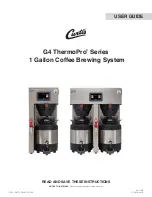
Weldmatic 180 | Operator Manual | Model No CP141-1
23
22
Stick Welding Operation
Be certain that you are wearing suitable
protective clothing, gloves etc and that
you are working in a non-hazardous area.
If necessary, refer again to Section 1 - Safe
Practices in this manual.
Connect the work clamp to the work piece.
Place the desired electrode in the
electrode holder.
Turn on the power switch located on the rear
panel. Wait approximately 5 seconds as the
unit goes through its initiation sequence.
Press the Weld Mode button until the Stick
Mode light is on.
Select an appropriate welding current for
the electrode diameter by setting the knob
on the machine front panel. WIA AUSTARC
electrodes will give the best results.
To strike the arc, drag the end of the
electrode along the work piece as if
striking a match. As the arc initiates, lift the
electrode slightly away, aiming to establish
an arc length of approximately 3 mm.
As the electrode end is consumed, feed the
electrode into the arc in order to maintain
arc length. As a general rule, the arc should
be held as short as possible while still giving
stable burn off and good weld appearance.
An arc which is too long cause an unwieldy
flow of metal with a rough weld appearance
and reduced penetration. An arc too short
leads to a narrow weld deposit and “stuttery”
arc characteristics, and the electrode is
liable to freeze onto the work piece.
As the solidified weld deposit forms, move
the end of the electrode slowly along
the weld path, aiming to maintain a pool
of moulten weld metal behind the arc.
Decreasing this rate of travel will result in a
wider weld deposit, and similarly increasing
it will narrow the weld deposit.
Always fill the crater which tends to form
at the end of a weld deposit, by pausing
momentarily before withdrawing the
electrode to break the arc. Unfilled craters
are a point of weakness, and can lead to
weld cracking.
Current Range for General Purpose
Electrodes
Diameter (mm) Current (Amps)
2.0
40 - 60
2.5
60 - 85
3.2
90 - 130
4.0
130 - 180
TIG Welding (GTAW)
Connection for TIG Welding
For TIG welding, the torch is connected to
the negative terminal. Figure 9 illustrates
the correct connection of the welding torch
and gas supply. Welding grade Argon is
the shielding gas most commonly used for
DC GTAW welding. The gas is connected
directly to the torch.
Before first use of the welding torch, allow
gas to purge the torch and hoses for
5 minutes at approximately 10 litres/min.
For welding purposes, the gas flow rate
should be set in the range 2-5 litres/min.
Tungsten electrodes for DC GTAW should
be 1-2% Thoriated or Witstar. This type will
provide the best arc initiation, arc stability
and tip shape retention characteristics.
Thoriated electrodes can be recognised by
a red coded end. The tungsten electrode
is ground to a point, with the grinding marks
pointing towards the tip. For welding currents
less than 20 amps, the included angle of the
point should be 30
o
, for currents greater than
20 amps, the recommended angle is 60
o
.
When set in the torch, the tungsten should
protrude 6 mm from the ceramic gas nozzle.
















































